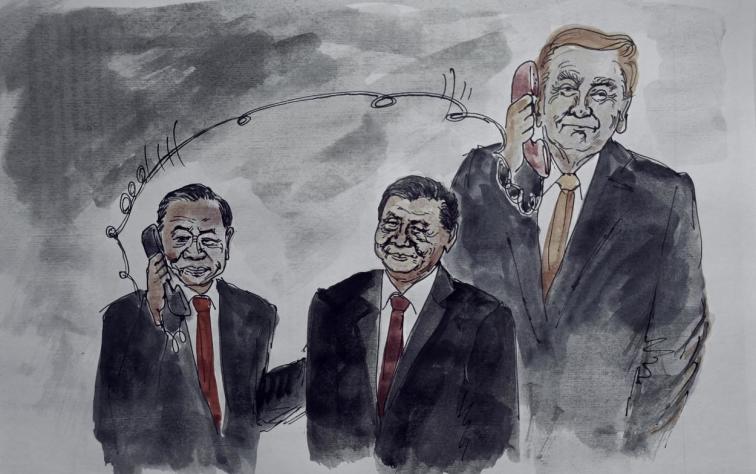March 11, 2023: Senior members of the CCP’s Central Military Commission line up to take the oath at the National People’s Congress. From right to left: Zhang Youxia, He Weidong, Li Shangfu, Liu Zhenli, Miao Hua, Zhang Shengmin. (Lintao Zhang/Getty Images)
[People News] On 13 August, the CCP’s military newspaper reported a short piece: Member of the Central Military Commission (CMC) and Chief of the CMC Joint Staff Department Liu Zhenli held talks with visiting Australian Defence Force (ADF) Chief General Johnston in China. The two sides had in-depth exchanges on bilateral military relations, international and regional security, and issues of common concern. They agreed to strengthen dialogue in the defence field and promote the development of relations between the two militaries. As of 14 August, the news was still online on the PLA’s military portal.
Military exchanges between China and Australia began in 1978. In 1982, the two countries exchanged military attachés. In the 1990s, bilateral exchanges gradually increased, and the two militaries began to hold regular China–Australia Defence Strategic Consultations. On the Chinese side, the CMC’s Chief or Deputy Chief of the Joint Staff Department participates.
For example, on 17 February this year, the 23rd China–Australia Defence Strategic Consultation was held in Beijing. It was co-chaired by CMC Deputy Chief of the Joint Staff Xu Qiliang, ADF Vice Chief Chipman, and Australia’s Deputy Secretary of Defence Jeffrey. This was the first such consultation since 2019, but the level was downgraded.
In October 2018, ADF Chief Campbell and Defence Secretary Moriarty visited China, co-chairing the 21st China–Australia Defence Strategic Consultation with CMC Joint Staff Chief Li Zuocheng. In November 2019, Li visited Australia to co-chair the 22nd consultation.
By past CCP military practice, when the Australian Defence Force Chief visits China, a Vice Chairman of the CMC usually meets with them.
For instance:
On 30 October 2018, then–CMC Vice Chairman Xu Qiliang met with Campbell and Moriarty, expressing hope that Australia would “move toward China, strengthen communication, enhance mutual trust, manage differences, and deepen pragmatic cooperation.” Campbell expressed willingness to strengthen cooperation.
On 13 October 2016, then–CMC Vice Chairman Fan Changlong met with ADF Chief Binskin and Defence Secretary Richardson. Fan referenced a meeting between Xi Jinping and the Australian Prime Minister, urging caution on the South China Sea issue. Binskin and Richardson expressed hopes for deeper exchanges, including personnel visits and joint training.
On 13 December 2012, then–CMC Vice Chairman Xu Qiliang met with ADF Chief David Hurley. Xu said China was willing to work together to contribute to regional stability. The next day, then–CMC Member and Minister of General Armaments Zhang Youxia also met Hurley’s delegation.
On 17 December 2010, then–Vice President and CMC Vice Chairman Xi Jinping met with ADF Chief Angus Houston and Defence Secretary Ian Watt, expressing hope to explore new areas of pragmatic cooperation. Houston and Watt stressed principles of “mutual trust, understanding, and respect.”
This time, however, when the ADF Chief visited China, it was Liu Zhenli who met with him, with Zhang Youxia absent. Why?
One reason might be that the Chinese side deliberately downplayed the visit. In February this year, a Chinese naval fleet conducted live-fire drills in the Tasman Sea between Australia and New Zealand, forcing some civilian flights to divert or change plans. This was seen as a show of China’s growing military reach, which sparked dissatisfaction in both Australia and New Zealand.
In July, Australian Prime Minister Albanese revealed that during his visit to Beijing, he complained to Xi Jinping about not being notified of the naval drills. Xi responded that Australia had conducted similar exercises—referring to Australian warships participating in freedom of navigation missions in the disputed South China Sea.
To counter China’s perceived threat, the United States and Australia held their largest-ever joint military exercise in Australia in July, involving over 30,000 troops from the US, Australia, and a record 19 partner nations.
On 9 August, after a meeting between the Australian and New Zealand prime ministers, both declared that their countries faced the most unpredictable and dangerous strategic environment in decades, and would strengthen military cooperation to protect common interests.
The CCP, naturally displeased, may have chosen to snub the ADF Chief’s visit—hence Zhang Youxia’s absence. However, judging from Liu Zhenli’s remarks, there was none of the usual “lecturing” tone toward Australia, so this explanation remains uncertain.
Another possible reason is that Zhang Youxia was preoccupied with internal CCP power struggles. With various signs suggesting Xi Jinping has lost both military and party authority, the early-August Beidaihe Meeting became particularly important. There is speculation it reached major decisions. Overseas sources claim Zhang ordered the 82nd Army’s special operations brigade—codenamed “Xiangjian” (“Flying Arrow”)—to enter Beidaihe, possibly as a form of “military remonstrance.”
Whatever the case, Zhang’s absence from the meeting with the ADF Chief indirectly confirms that Beidaihe is unsettled and that nothing has been conclusively resolved.










News magazine bootstrap themes!
I like this themes, fast loading and look profesional
Thank you Carlos!
You're welcome!
Please support me with give positive rating!
Yes Sure!